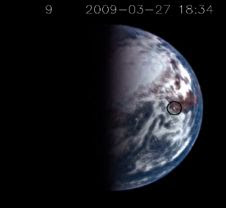 In two new videos from NASA’s Deep Impact spacecraft, bright flashes of light known as sun glints act as beacons signaling large bodies of water on Earth. These observations give scientists a way to pick out planets beyond our solar system (extrasolar planets) that are likely to have expanses of liquid, and so stand a better chance of having life.
In two new videos from NASA’s Deep Impact spacecraft, bright flashes of light known as sun glints act as beacons signaling large bodies of water on Earth. These observations give scientists a way to pick out planets beyond our solar system (extrasolar planets) that are likely to have expanses of liquid, and so stand a better chance of having life.These sun glints are like sunshine glancing off the hood of a car. We can see them reflecting off a smooth surface when we are positioned in just the right way with respect to the sun and the smooth surface. On a planetary scale, only liquids and ice can form a surface smooth enough to produce the effect—land masses are too rough—and the surface must be very large. To stand out against a background of other radiation from a planet, the reflected light must be very bright. We won’t necessarily see glints from every distant planet that has liquids or ice.
“But these sun glints are important because, if we saw an extrasolar planet which had glints that popped up periodically, we would know that we were seeing lakes, oceans or other large bodies of liquid, such as water,” says Drake Deming, of NASA’s Goddard Space Flight Center in Greenbelt, Md. Deming is the deputy principal investigator who leads the team that works on the Extrasolar Planet Observations and Characterization (EPOCh) part of Deep Impact’s extended mission, called EPOXI. “And if we found large bodies of water on a distant planet, we would become much more optimistic about finding life.”
One of EPOCh’s goals is to observe the Earth from far away—in this case, about 11 million miles away—so that we know what an Earth-like planet would look like when viewed from our spacecraft. The images in these videos were collected when the spacecraft was close enough to resolve some of Earth’s features, but at the same time, Earth could be treated as a very distant, single point. “This allows us to properly simulate what we would have observed if Earth were an extrasolar planet,” says Michael A’Hearn, principal investigator for EPOXI.
The researchers expected to see the sun glints but were surprised by the intensity and small focus of some, says Goddard’s Richard K. Barry. Glints appeared over oceans, most likely in relatively calm patches, and over a few land masses, probably caused by large inland lakes. Barry, who is leading the Earth-glint research effort, is putting together a catalog that will relate each glint to an exact location on Earth.
Together, the new videos provide the first view of Earth for a full rotation from the north pole (shown in one video) and south pole (the second video). The resolution is high enough to distinguish land masses, bodies of water and clouds. Each 16-second video is a compilation of a series of green, blue and near-infrared images taken every 15 minutes on a single day. Each is also the end product of months of planning, sophisticated data processing and analysis by the team.
No comments:
Post a Comment